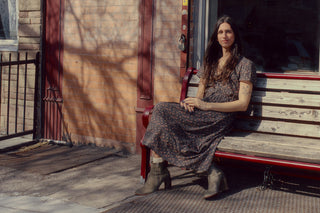The words of writer and activist Willow Defebaugh call us to remember the innate wisdom we all share: the knowing of our deep connection with Mother Earth. In illuminating the inextricable connection between climate and culture, Willow’s work urges all of us to recognize ourselves in Nature, examining the ways we care for the Earth, ourselves and one another.

Tell us about yourself!
Growing up in Michigan, I was always inspired by nature and storytelling. In college, I studied creative writing and journalism with a focus on the environment. I moved to New York City to pursue a career in the publishing world, spending my twenties working at art, culture, and fashion magazines. As the ecological crisis grew louder, I decided that I needed to be more intentional with the stories I was telling, which led to the creation of Atmos.
What inspired the birth of Atmos?
Atmos was born out of a question: what would happen if we took the talent and creativity of the art and fashion worlds and applied them to storytelling about the environment? For decades, the climate crisis was communicated through a cold and purely data-driven lens. We wanted to explore it through a human lens — one that showed people that the climate crisis is a human crisis, because humans and Nature are inseparable.
 Willow is wearing The Emerson Dress In Oak Leaf
Willow is wearing The Emerson Dress In Oak Leaf
How did you begin to understand the connection between climate and culture?
“Climate and culture” is how we describe the magazine’s focus, but in many ways, the point is that these two things are the same. Our very first issue was themed “Neo-Natural” because we were interested in the point at which we began to think of “natural” as anything outside of the human realm. Language and the words that we use in storytelling play a huge role in how we function. That linguistic divide is a big part of why we see the world as something outside of ourselves. When you understand that Nature is a part of us, and we are a part of Nature, you become naturally moved to protect it. A culture is an ecosystem, an organism. It’s how we relate not just to each other, but to our environment. If we want to change our relationship to the Earth, we must change our culture, which is to say our worldview. And if you want to change culture, to change people’s minds, the most powerful way I know how to do that is through stories.
 Willow is wearing The Sabrina Dress In Apple Blossom
Willow is wearing The Sabrina Dress In Apple Blossom
What inspires you most?
Nature has always been my inspiration. Every Friday, I publish a newsletter for Atmos called The Overview. Each edition looks to a different aspect of the natural world and what it can teach us through the lens of deep ecology. Sometimes I’ll focus on a plant species, other times it’s an ecosystem or a naturally occurring process. Everywhere we look in Nature, life is showing us the way forward.

What’s the most valuable lesson that this work has taught you?
How systemic change really happens. It can be easy to despair when governments are not treating the climate crisis as the emergency that it is. But that thinking denotes a failure to grasp that the individual is the collective. Everything in Nature exists in a fractal conception; you change some parts of the pattern and you start to re-pattern the whole. Every day in my work I am connected to different individuals—like Christy and her team—who are reweaving how things are done across so many different industries. It gives me great confidence to know how many people are out there affecting their own ecosystems, and by extension, the larger ecosystem we are all part of.
 Willow is wearing The Dawn Dress In Black Cosmos Floral
Willow is wearing The Dawn Dress In Black Cosmos Floral
How do you incorporate sustainability in your personal life?
Lately I have been thinking about sustainability more by way of reciprocity, which is to say my relationships. Not just to people, but to my body, the food I eat, my local ecosystem, the clothes I wear. Instead of just thinking “Is this sustainable?” I think “Is this relationship sustainable?” Everything we buy or bring into our lives, we enter into relationship with. Don’t you want your relationships to be the healthiest they can be? And to me, a healthy relationship looks like one that is long-lasting, nurturing, and reciprocal.
How do you Honor Mother Earth?
Mother Earth has given all of us so much. I try to honor her by giving back some small fraction of that in return. The way that we can give back is entirely individual and based on our unique gifts and perspectives. She gave me the ability to weave words, so I spin them all for her.





